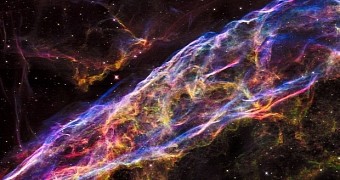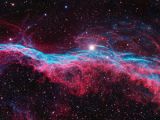Some 8,000 years back, a star located in the constellation Cygnus, at a distance of about 2,100 light-years from our planet, reached the end of its life and, well, went kaboom.
Its scattered remains created what scientists call the Veil Nebula, basically a cosmic pile of debris that's forever expanding and that now measures an estimate 110 light-years from one end to the other.
Recently, the Hubble Space Telescope took some time peering into the anatomy of the Veil Nebula and snapped images of filamentary structures found within a segment about 2 light-years across.
These images were then combined into a gorgeous mosaic. As impressive as it might be, this view is merely an infinitesimal fraction of the Veil Nebula, astronomers explain.
“NASA’s Hubble Space Telescope has unveiled in stunning detail a small section of the expanding remains of a massive star that exploded about 8,000 years ago,” they write in the image's description.
“This view is a mosaic of 6 Hubble pictures of a small area roughly 2 light-years across, covering only a tiny fraction of the nebula's vast structure,” the description further reads.
In this view of part of the Veil Nebula, the color red indicates the distribution of hydrogen, NASA scientists say. Then there's green for sulfur and blue for oxygen. The star that birthed the Veil Nebula when exploding into a supernova about 8,000 years ago is believed to have been around 20 times more massive than our Sun, which explains why the nebula itself is pretty darn gigantic.

 14 DAY TRIAL //
14 DAY TRIAL // 



